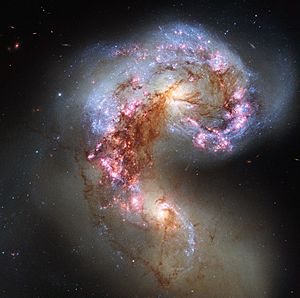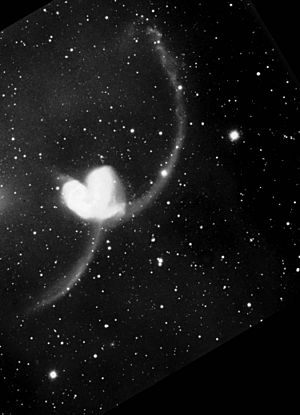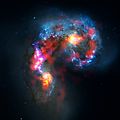Antennae galaxies facts for kids
Quick facts for kids Antennae galaxies |
|
|---|---|

NGC 4038 (left) and NGC 4039 (right)
|
|
| Observation data (J2000 epoch) | |
| Constellation | Corvus |
| Right ascension | 12h 01m 53.0s / 12h 01m 53.6s |
| Declination | -18° 52′ 10″ / -18° 53′ 11″ |
| Redshift | 1642 ± 12 / 1641 ± 9 km/s |
| Distance | 45 Mly / 65 Mly |
| Type | SB(s)m pec / SA(s)m pec |
| Apparent dimensions (V) | 5′.2 × 3′.1 / 3′.1 × 1′.6 |
| Apparent magnitude (V) | 11.2 / 11.1 |
| Notable features | Interacting galaxies |
| Other designations | |
| Ringtail Galaxy, NGC 4038 / 4039, PGC 37967 / 37969, Arp 244, Caldwell 60/61 |
|
| See also: Galaxy, List of galaxies | |
The Antennae galaxies are two galaxies that are crashing into each other! They are also known as NGC 4038 and NGC 4039. You can find them in the constellation called Corvus. This amazing cosmic crash takes a very long time, maybe even a billion years!
The collision makes lots of gas, dust, and magnetic fields smash together. This causes many new stars to form very quickly. This period is called a "starburst phase." It might last for hundreds of millions of years. A famous astronomer named William Herschel first saw these galaxies in 1785.
The Antennae galaxies are part of a group of galaxies called the NGC 4038 group. This group includes five other galaxies. Before they started crashing, NGC 4038 was a barred spiral galaxy. NGC 4039 was a regular spiral galaxy.
Contents
Why are they called Antennae Galaxies?
These two galaxies are called the Antennae galaxies because of their shape. When they collide, long tails of stars, gas and dust are pulled out. These tails look like the antennae of an insect. This happens because of strong tidal forces during the crash.
What will happen next?
The central parts, or nuclei, of the two galaxies are slowly joining together. In the future, they will become one giant Elliptical galaxy.
How far away are they?
Scientists used to think these interacting galaxies were 65 million light-years away. But new studies show they are actually closer. They are about 45 million light-years from our own Milky Way galaxy.
Images for kids
-
Visible light Hubble image (blue) showing newly formed young stars overlaid with a radio image from the Atacama Large Millimeter Array showing the clouds of dense cold gas from which new stars form (red, pink and yellow)
See also
 In Spanish: Galaxias Antennae para niños
In Spanish: Galaxias Antennae para niños




